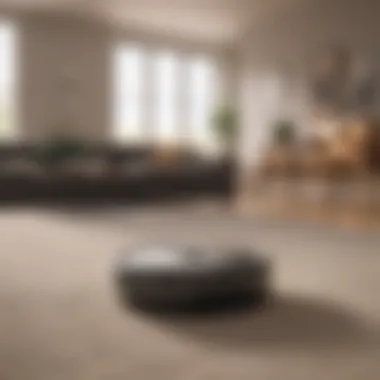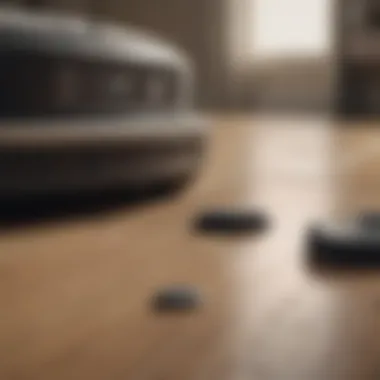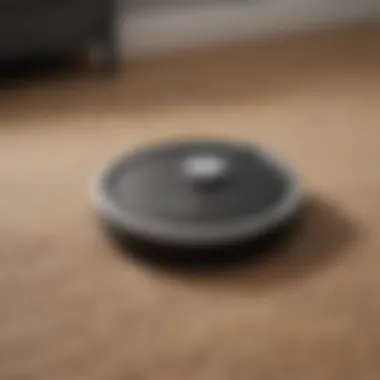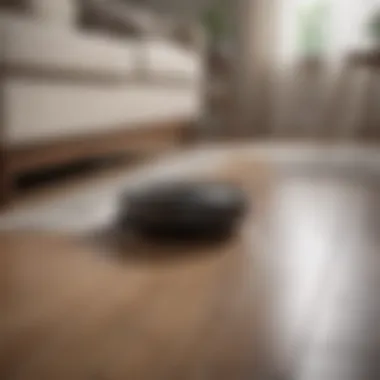Top Robot Vacuums of 2023: Expert Rankings and Reviews


Intro
The proliferation of technology in everyday household chores has led to a significant shift in how we approach cleaning. This transformation has given rise to the popularity of robot vacuums. With the ability to autonomously navigate through homes, these devices have become vital tools for homeowners seeking convenience and efficiency.
As the market evolves, it becomes increasingly important to understand the nuances of various models available. Each robot vacuum promises unique features, strengths, and weaknesses. This overview aims to arm readers with the necessary insights to make informed choices when selecting a robotic cleaning solution. Through rigorous analysis and customer feedback, the examination of these products reveals trends that can shape purchasing decisions.
Key Insights and Trends
In the landscape of household cleaning, robot vacuums have become staples for many homeowners. Recent trends highlight their emergence not just as luxuries, but as essential companions in maintaining cleanliness.
Popular Features Among Users
Today's robot vacuums come with an array of features tailored to improve user experience:
- Smart Mapping Technology: Many models utilize sophisticated algorithms to map the layout of the home, enhancing cleaning efficiency.
- Integration with Smart Home Systems: Users appreciate vacuums that seamlessly cooperate with other smart devices, allowing for remote operation and scheduling.
- Advanced Filtration Systems: Models with HEPA filters attract those concerned about allergens and indoor air quality.
The growing trend of integrating advanced robotics and artificial intelligence showcases how technology is redefining home cleaning tasks. Consumers are increasingly valuing devices that not only meet cleaning standards but also offer seamless user experiences.
Price Range and Accessibility
The market for robot vacuums caters to a diverse audience with varying financial capacities. Models are available across a spectrum of price points, making them accessible to a wide array of consumers. The most basic models start at around $200, while high-end options can exceed $1,000. Customers tend to draw conclusions based on features relative to price, which underscores the importance of a balanced evaluation in the buying process.
Practical Tips for Choosing the Right Robot Vacuum
Navigating the selection process might feel daunting. To simplify it, here are some actionable tips:
- Evaluate Your Home Layout: Assess the size of your home and the layout. Homes with more complex layouts may benefit from vacuums equipped with advanced mapping capabilities.
- Consider Your Cleaning Needs: Different households have unique cleaning requirements. If you have pets, look for models specifically designed to handle pet hair.
- Read Customer Reviews: User feedback often reveals insights about performance and potential issues that manufacturers may not advertise.
"The best robot vacuum is the one that fits your specific needs, rather than simply following market trends or expert reviews."
- Trial and Error: If possible, take advantage of return policies. Understanding how a vacuum performs in your home is invaluable.
With an informed approach, homeowners and renters can identify the most suitable robot vacuum tailored to their cleaning needs and preferences. This active engagement will help in capitalizing on the best offerings available in the market.
Foreword to Robot Vacuums
Robot vacuums represent a shift in how we approach cleaning our homes. Their relevance today is clear. With life becoming increasingly busy, the demand for smart technologies that simplify daily tasks keeps rising. This section aims to unfold the significance of robot vacuums and their contributions to modern home cleaning.
The Evolution of Home Cleaning Technology
Over the years, cleaning technology has undergone significant changes. Traditional vacuum cleaners, which required manual effort, have evolved into automated devices. The introduction of robot vacuums began in the early 2000s. Products like the Roomba from iRobot pioneered this space, demonstrating that cleaning could be done with minimal human intervention.
The advancements in technology did not stop there. Initially, these devices had limited navigation capabilities and basic suction power. However, modern robot vacuums now feature sophisticated sensors and mapping technologies. These enhancements allow them to navigate complex spaces effectively, avoiding obstacles and adapting to different floor types. Manufacturers invest heavily in research to keep developing more efficient models. It’s worthwhile to note that the simplest advancements often yield the most significant benefits and usability for everyday consumers.
Understanding the Value of Automation
Automation in the home serves several purposes. Reducing the time spent on mundane tasks is perhaps its most marketed advantage. Robot vacuums can operate independently. This capability means users can attend to more important activities while the vacuum cleans. Moreover, these devices often follow a programmable schedule; a user can set it to run at times when they are not home, making effective use of technology.
Additionally, the convenience they offer is not limited to time. Robot vacuums also help maintain a consistently clean living environment, which contributes to better indoor air quality. Regular cleaning can reduce allergens and dust particles in the home. Overall, the automation provided by these vacuums greatly improves quality of life for users, making it an investment well worth considering.
"The integration of automation in home cleaning is not just a trend, but a testament to the evolving needs of modern lifestyles."
Criteria for Evaluation
Evaluating robot vacuums involves examining several critical factors that contribute to overall performance and user experience. The right criteria help consumers make informed decisions by weighing what matters most to them. Each aspect affects how effectively a robot vacuum will operate in various environments while addressing specific needs and preferences.
Suction Power and Performance
Suction power is one of the foremost indicators of a robot vacuum's capability. It determines how well a device can pick up dirt, dust, and debris from different surfaces. A robot vacuum with strong suction power will perform better on carpets, where particles can become embedded. Conversely, a model with less suction may struggle to provide reliable cleaning performance on harder surfaces or thick rugs.
Key aspects to consider include:
- Specifications: Look for vacuum models that explicitly detail suction power measured in Pascal (Pa). Higher numbers often signify better deep cleaning.
- Real-World Performance: User reviews can provide insights into actual performance under various conditions. They can highlight any concerns with pet hair or fine dust removal versus the manufacturer's claims.


Navigation Technology
Advancements in navigation technology have significantly improved robot vacuum efficiency. Modern vacuums equipped with sensors, mapping capabilities, and intelligent pathfinding systems tend to operate more effectively.
- Sensor Technology: Models equipped with LiDAR or infrared sensors can better avoid obstacles and navigate complex layouts, which may minimize cleaning time.
- Mapping Features: Some models create maps of your home, allowing for customized cleaning patterns rather than random paths.
- User Control: Ability to specify cleaning zones or no-go areas enhances user customization of the machine's operation.
Battery Life and Efficiency
Battery life directly influences how much area a robot vacuum can clean in a single charge. Models with longer battery life can operate for extended periods, covering larger areas without interruption. This aspect is crucial for homeowners with expansive spaces.
- Types of Batteries: Variants can significantly affect performance. Lithium-ion batteries show better longevity compared to lead-acid alternatives.
- Charging Station: Check if the unit can return to its docking station for recharging, as not all models have this feature, potentially limiting their usability during longer sessions.
Ease of Use and Maintenance
A high-performing vacuum that is difficult to use or maintain may negate its advantages. Consumers should prioritize devices that simplify the cleaning process and require minimal upkeep.
- User-Friendly Controls: Look for intuitive controls or mobile app functionalities that allow easy operation.
- Maintenance Needs: Verify how often brushes need replacing and what it takes to clean dust bins and filters. Complexity in maintenance could discourage regular use.
Smart Features and Integration
Integration with smart home technology is increasingly desired. Many users appreciate robot vacuums that align with their digital lifestyle, providing added convenience.
- Voice Control: Compatibility with devices like Amazon Alexa or Google Assistant can make operation simpler through voice commands.
- Scheduling Options: Features that allow for setting cleaning schedules can enhance usability, especially in busy households.
- Integration with Smart Homes: Look for models that can connect with home systems for better overall management.
Customer Feedback and Reliability
User reviews and ratings play a significant role in assessing the reliability and performance of robot vacuums. Researching feedback provides valuable insights into how other consumers perceive a model.
- Real-Life Experiences: Dive into detailed reviews to see firsthand how models perform over time. Users often discuss durability, customer service issues, and their cleaning effectiveness.
- Ratings and Recommendations: Websites like Reddit or consumer review hubs can offer crowdsourced evaluations of different models, highlighting both the strengths and weaknesses of specific units.
"When selecting a robot vacuum, consider multiple factors for a well-rounded decision—customer feedback, specific features, and device maintenance can greatly impact satisfaction."
By examining these criteria in-depth, potential buyers can build a clearer picture of which robot vacuums suit their individual needs. These evaluations lead to smarter purchasing decisions, ultimately enhancing the home cleaning experience.
Top Robot Vacuums of the Year
In the realm of home cleaning technologies, the significance of identifying the top robot vacuums cannot be overstated. Each year, innovations lead to new models that not only enhance efficiency but also offer a variety of features catering to diverse household needs. Recognizing the best options means evaluating factors like performance, cost, and user feedback, ensuring that consumers can make informed choices without wasting time or money on subpar products. This section delves into the top robot vacuums available in the market today, providing insights that help users choose wisely based on their specific requirements.
High-End Models
Features and Pricing
High-end models of robot vacuums come equipped with advanced features often justifying their price premium. These might include superior navigation systems, powerful suction capabilities, and smart home integration options. Price points for high-end models can range significantly, often exceeding a thousand dollars. However, the investment can result in cleaner floors and reduced time spent on manual cleaning. One notable example is the iRobot Roomba s9+, known for its exceptional cleaning performance and self-emptying feature, making it a popular choice among users who seek convenience alongside high functionality.
User Reviews
Feedback from users is crucial when assessing high-end robot vacuums. Reviews tend to highlight both satisfaction and areas needing improvement. Users often report that models like the Roborock S7 provide impressive suction on various surfaces, while others express dissatisfaction due to complex user interfaces or connectivity issues. Collecting and analyzing this feedback helps potential buyers understand not just the strengths but also the pitfalls of premium models, thereby facilitating more informed purchasing decisions.
Pros and Cons
When considering high-end vacuum models, it's essential to weigh the advantages against the disadvantages.
Pros:
- Exceptional cleaning performance across different surfaces.
- Advanced features such as mapping and scheduling.
- Quality that often comes with longer warranties and customer service.
Cons:
- Higher price, which may not fit all budgets.
- Possible feature overload for users who need simple solutions.
Mid-Range Alternatives
Features and Pricing
Mid-range robot vacuums offer a balance between cost and functionality. Priced typically between three hundred and seven hundred dollars, these models provide respectable cleaning capabilities without the hefty price tag of high-end options. Features such as decent suction power and basic mapping are common, making them suitable for most homes. For instance, the Eufy RoboVac 30C has carved a niche for itself by delivering solid performance and ease of use at a reasonable price.


User Reviews
User reviews on mid-range vacuums often reflect the blend of quality and affordability. Customers tend to appreciate features that deliver good value for money. However, they sometimes mention limitations in suction compared to high-end models or occasional connectivity hiccups. Reading through these reviews helps potential buyers gauge whether they can compromise on certain advanced features in exchange for more budget-friendly options.
Pros and Cons
The decision to choose a mid-range vacuum should be supported by a thorough evaluation of its pros and cons.
Pros:
- Affordable without compromising too much on performance.
- Well-suited for families or individuals needing basic cleaning assistance.
Cons:
- May lack advanced features such as extensive smart home integration.
- Mixed performances on different surfaces compared to premium models.
Budget-Friendly Options
Features and Pricing
Budget-friendly robot vacuums can be found at prices under three hundred dollars. While these vacuums often have fewer features, they can provide basic cleaning needs effectively. Models like the ILIFE V3s Pro offer strong performance at a low cost. This makes them appealing to users who want a robot vacuum but don’t need advanced functionalities.
User Reviews
Users often express appreciation for budget models due to their low cost and decent cleaning ability. However, they also frequently report limitations in navigation and suction power. Understanding these user reviews can help budget-conscious buyers set realistic expectations about what they are purchasing.
Pros and Cons
When considering budget-friendly robot vacuums, analyzing their pros and cons is essential.
Pros:
- Highly affordable and accessible for most households.
- Sufficient for maintaining cleanliness in smaller spaces or less demanding environments.
Cons:
- Limited features and often basic cleaning performance.
- Potentially shorter lifespan and less robust construction compared to pricier models.
Comparative Analysis
Comparative analysis is crucial when it comes to evaluating robot vacuums. It allows consumers to delve deeper into the distinct characteristics and performance of various models. By examining metrics such as cleaning efficiency, noise levels, and total cost of ownership, potential buyers gain clarity about which vacuum suits their needs best. The outcome is informed decision making that prioritizes individual requirements over mere brand loyalty or marketing claims.
Performance Across Different Floor Types
Different floor types pose unique challenges for robot vacuums. Understanding how each model performs across these surfaces is essential for optimal cleaning results.
Hardwood Floors
Hardwood floors are a popular choice in many homes, valued for their aesthetic appeal. Robot vacuums designed for hardwood floors often feature specialized brushes that prevent scratches. These vacuums typically utilize softer materials in their construction to gently glide over surfaces without damaging them.
However, not all models excel on hardwood. Some may struggle with fine debris like dust, while others might leave behind larger particles. The effectiveness of a robot vacuum on hardwood may depend on its suction power and navigation capabilities.
Carpets
When it comes to carpets, suction power is paramount. Robots designed for carpet cleaning usually feature beater bars or brush rolls that help dislodge dirt and hair embedded in fibers. A key characteristic of carpet-friendly models is their ability to adjust suction based on carpet height.
Even with significant advancements, many consumers report mixed results on this type of surface. Some robot vacuums may get stuck or fail to thoroughly clean areas with high-pile carpets. Prospective buyers should consider their carpet type before investing.
Tiled Surfaces
Tiled surfaces, which are often seen in kitchens and bathrooms, require specific features in robot vacuums as well. These vacuums benefit from strong suction capability, as tile can accumulate dust and grime easily. Most models come equipped with specialized cleaning modes suitable for smooth surfaces.
A notable advantage is the ease of maneuverability since tiles tend to be flatter compared to carpets. However, many models may experience difficulty with grout lines, which trap dirt and debris. This shortcoming can affect overall cleaning performance, making effective navigation highly important in this context.


Noise Levels and Disruption
Noise levels from robot vacuums can vary significantly among models. Quiet operation is often a priority for users, particularly in household settings where minimizing disruption is necessary. Many advanced models utilize sound-dampening technology to reduce noise.
While less noisy, some may still emit distracting sounds during operation.
Total Cost of Ownership
A comprehensive evaluation of robot vacuums extends beyond the purchase price to include total cost of ownership, which includes initial investment, maintenance costs, and energy consumption.
Initial Investment
The initial investment for a robot vacuum can vary widely. Higher-end models often come with advanced features, while budget options may lack functionality. Consumers must determine what level of investment is acceptable based on their cleaning needs. The potential for longevity and durability further influences this decision.
Maintenance Costs
Maintenance costs refer to ongoing expenses, such as replacement parts and cleaning supplies. For instance, some models require frequent brush replacement or filter cleaning. Understanding these costs can impact the overall budget for robot vacuum ownership. Regular maintenance is necessary for the longevity of the vacuum.
Energy Consumption
Energy consumption is a critical aspect to consider. Robot vacuums are generally energy-efficient, but there are differences among models. Consumers should evaluate how frequently they plan to use the robot, as this could significantly impact energy costs over time. An efficient model may justify a higher initial investment by saving costs in the long run.
"A well-informed consumer is equipped to navigate the complexities of robot vacuum ownership."
In summary, comparative analysis serves as an essential framework for understanding performance across different floor types, evaluating noise levels, and assessing total cost of ownership.
Future of Robot Vacuums
The realm of robot vacuums is evolving rapidly, reflecting significant advancements in technology, environmental awareness, and consumer preferences. Understanding the future of these cleaning devices is crucial for potential buyers. It highlights which innovations will enhance cleaning efficiency, user experience, and sustainability. Homeowners, interior design enthusiasts, and eco-conscious individuals need to grasp how these trends could influence their purchasing choices.
Advancements in AI and Machine Learning
Artificial intelligence and machine learning are being increasingly integrated into the design and operation of robot vacuums. These technologies foster smarter cleaning solutions, enabling the devices to learn about their environment. Over time, they adapt to the layout of a home, optimizing their cleaning patterns and schedules.
This leads to several benefits:
- Improved Efficiency: AI-enabled vacuums can evaluate the dirtiness of areas and allocate resources accordingly. This targeted approach saves cleaning time.
- Obstacle Avoidance: Advanced sensors allow the robots to navigate around furniture and other obstacles more effectively, reducing interruptions during their operation.
- Remote Access and Control: Many AI-driven models offer smartphone compatibility. Users can manage cleaning sessions remotely, customize settings, and receive real-time updates.
Overall, advancements in AI and machine learning are reshaping the robot vacuum landscape, equipping them with the capabilities that were unimaginable just a few years ago.
Sustainability and Eco-Friendly Practices
Sustainability has become a vital aspect of consumer choices, including household appliances. Robot vacuum manufacturers are increasingly focusing on eco-friendly practices. They are enhancing their products, not just in cleaning ability but also in how they impact the environment.
Important considerations include:
- Energy Efficiency: Many modern models are designed to consume less power, helping reduce energy bills without sacrificing performance.
- Recyclable Materials: Manufacturers are working towards using recyclable materials in their parts and packaging, promoting a circular economy.
- Longer Lifespans: Improvement in product durability and functionality means that users can expect longer life from their vacuums, reducing waste.
Investing in eco-friendly robotic vacuums contributes to a less burdensome impact on the planet.
The path forward for robot vacuums appears promising, with ongoing innovations in AI and a strong emphasis on sustainability shaping the industry's future. For home users, these developments will likely translate into smarter, more efficient, and environmentally responsible cleaning solutions.
Culmination
The conclusion is a quintessential part of this article as it encapsulates the key insights into robot vacuums, offering direction to potential buyers. When assessing the right model, homeowners must weigh factors such as cleaning efficiency, ease of use, and overall value. This section serves as a compass for readers who have navigated the complexity of robot vacuum options and are seeking clarity in their decisions.
Choosing the Right Model for Your Home
Determining the ideal robot vacuum involves several personal considerations. Key elements include:
- Home Size: Larger homes may require a model with extended battery life and advanced navigation.
- Flooring Type: Consider whether your home has hardwood, carpet, or tile, as different vacuums excel on various surfaces.
- Allergies and Pets: If you suffer from allergies or have pets, look for models with effective filtration systems that can trap allergens and pet hair.
- Budget: Evaluate what features matter most to you. High-end models may offer advanced smart features, but mid-range options can also provide robust cleaning.
Ultimately, understanding the specific structure and needs of your home can guide you in selecting a robot vacuum that fits your lifestyle.
Final Thoughts on Robot Vacuums
Robot vacuums represent a blend of technology and convenience, making them increasingly popular among homeowners. As you consider an investment in robotic cleaning, gathering insights from user experiences and reliability data is essential. These devices not only save time but also provide effective cleaning solutions that adapt to various environments.
In summary, seeking a perfect balance between features, performance, and price will lead to a satisfactory purchase. Remember that the right choice can lead to a more manageable cleaning routine and an overall healthier living space. As technology continues to evolve, keeping abreast of advancements in this field will ensure you make the best decision for your needs.
"The integration of smart technology in household cleaning tools is redefining how we maintain our spaces."



